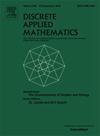A survey of the monotonicity and non-contradiction of consensus methods and supertree methods
IF 1
3区 数学
Q3 MATHEMATICS, APPLIED
引用次数: 0
Abstract
In a recent study, Bryant, Francis and Steel investigated the concept of “future-proofing” consensus methods in phylogenetics. That is, they investigated if such methods can be robust against the introduction of additional data like added trees or new species. In the present manuscript, we analyze consensus methods under a different aspect of introducing new data, namely concerning the discovery of new clades. In evolutionary biology, often formerly unresolved clades get resolved by refined reconstruction methods or new genetic data analyses. In our manuscript we investigate which properties of consensus methods can guarantee that such new insights do not disagree with previously found consensus trees, but merely refine them, a property termed monotonicity. Along the lines of analyzing monotonicity, we also study two established supertree methods, namely Matrix Representation with Parsimony (MRP) and Matrix Representation with Compatibility (MRC), which have also been suggested as consensus methods in the literature. While we (just like Bryant, Francis and Steel in their recent study) unfortunately have to conclude some negative answers concerning general consensus methods, we also state some relevant and positive results concerning the majority rule () and strict consensus methods, which are amongst the most frequently used consensus methods. Moreover, we show that there exist infinitely many consensus methods which are monotonic and have some other desirable properties.
求助全文
约1分钟内获得全文
求助全文
来源期刊

Discrete Applied Mathematics
数学-应用数学
CiteScore
2.30
自引率
9.10%
发文量
422
审稿时长
4.5 months
期刊介绍:
The aim of Discrete Applied Mathematics is to bring together research papers in different areas of algorithmic and applicable discrete mathematics as well as applications of combinatorial mathematics to informatics and various areas of science and technology. Contributions presented to the journal can be research papers, short notes, surveys, and possibly research problems. The "Communications" section will be devoted to the fastest possible publication of recent research results that are checked and recommended for publication by a member of the Editorial Board. The journal will also publish a limited number of book announcements as well as proceedings of conferences. These proceedings will be fully refereed and adhere to the normal standards of the journal.
Potential authors are advised to view the journal and the open calls-for-papers of special issues before submitting their manuscripts. Only high-quality, original work that is within the scope of the journal or the targeted special issue will be considered.
 求助内容:
求助内容: 应助结果提醒方式:
应助结果提醒方式:


